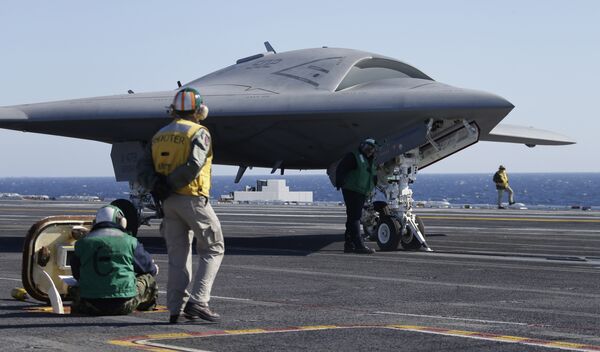In his article for British weekly newsmagazine The Week, Mizokami outlined why US aircraft carriers, which face increased strain from advances in anti-ship and anti-aircraft missile technology, may not be obsolete after all.
"Earlier this month," the defense analyst recalls, "the British Royal Navy ship HMS Protector made history. An ice patrol ship, Protector sailed the frigid waters off Antarctica. But instead of using a helicopter to scout an ice-free route, the Protector had an unlikely helper – a drone. And not just any drone: a 3D printed drone that was manufactured onboard the ship itself."
This diddy 3D-printed drone sniffs out ice for the Royal Navy https://t.co/cQV7suvYnU pic.twitter.com/BRLcXySw60
— Gizmodo UK (@GizmodoUK) 18 апреля 2016 г.
The idea, Mizokami suggests, "could be an unlikely savior of the largest warships ever to sail: aircraft carriers."
The 10 aircraft carriers currently deployed by the US Navy, with their 70 combat aircraft apiece, remain a force to be reckoned with, each of them "capable of bringing more firepower than the armed forces of entire countries. They are, in fact, a capability no other country can currently equal," the analyst notes.
China, for example, "is pursuing so-called 'anti-access, area denial' technologies that it hopes will make large parts of the Pacific too dangerous for aircraft carriers," including the deployment of the Dong Feng-26 'carrier killer' ballistic missile. "Launched from bases in China, the DF-26 was designed to attack aircraft carriers, plunging through the atmosphere at hypersonic speeds and punching through their steel decks. The DF-26 and weapons like them are notoriously hard to shoot down." Russia too has its own advances in this area.
Expense, is another problem, Mizokami notes, pointing to the USS Gerald R. Ford's record-breaking $17.5 billion R&D and production costs. And that doesn't even include the $6 billion in outlays for aircraft, and billions more for the support ships that comprise a typical carrier battle group. "All in all, the Ford's carrier battle group will easily cost somewhere around $30 billion."
Still, the analyst says, recent developments in technology mean the aircraft carrier may yet have a bright future. "The aircraft carrier's greatest strength, which has allowed it to remain relevant for the last 70 years, is the fact that it carries airplanes – and airplanes can be adapted to a wide variety of missions," up to and including the launch of nuclear weapons, destroying enemy fleets and bringing relief to disaster zones (presumably after having bombed them). "It's a versatility unmatched by any other ship."

"As aviation technology marches on, much of it makes its way onto aircraft carrier flight decks. In 2013 and 2014, the Navy's experimental X-47B unmanned carrier aircraft performed takeoffs, landings, and aerial refueling."
Now, the US Navy has also laid out plans to produce its first carrier-based drone, the MQ-25 Stingray.
The MQ-25 Stingray
— Peter W. Singer (@peterwsinger) 15 марта 2016 г.
Navy's new #drone has a new name, more gas, less stealth, maybe armedhttps://t.co/NJmkkP4Anx pic.twitter.com/QBWj5TbvOq
And this, Mizokami notes, is where things get interesting. "More drones will follow, and it's not farfetched to think of a day when none of the aircraft on a carrier actually carry any pilots." Moreover, given developments in 3D printing technology, including the ability to print steel, aluminum and titanium, "there's no reason why the technology, scaled larger, couldn't be used to create larger drones."
"A 3D printer capable of making aircraft fuselages, coupled with stores of pre-assembled aircraft components would enable the ship to build its own combat drones." In effect, "the carrier becomes not just a floating airport, but a floating airplane factory."
The types of aircraft built and launched from the floating factories could also be reconfigured; losses could be replaced on the spot. "Combat aircraft would go from being a precious resource to actually being somewhat disposable – and capable of being built in large numbers."
While Mizokami describes the technology behind the floating drone factory in detail, he doesn't contemplate the political and moral dimensions of the idea. Surely the people living in countries that have fallen out of Washington's favor won't welcome such carriers pulling up near their shores. Nor will those who criticize drones for turning the act of killing human beings into a virtual, 'videogame-like' experience.
Finally, with such floating drone factories promising to further reduce the costs of warfare (including possible pilot losses), who's to say that the idea couldn't serve to satisfy the itchy trigger fingers of Pentagon war planners?




